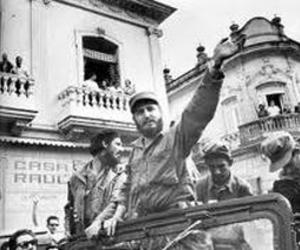Cuban exposition about its history
- Submitted by: manso
- Society
- 01 / 02 / 2011

Veenu Sandhu / New Delhi January 02, 2011, 0:46 IST. Che Guevara.Never-before-seen photographs of Che Guevara see the light of day.Cuba. 1964. The little island country in the Caribbean was just about beginning to find its feet. Five years ago, in 1959, the revolution led by Fidel Castro had wrenched the nation out of the hands of dictator Fulgencio Batista.
The mood of the people was upbeat. Their exuberance and resilience were palpable. It was a Cuba that was yet to shake off the shadow of the past, but was at the same time reaching out for a future that promised employment, development and freedom from poverty.
It was at this time that Colombia-born Mexican photographer Rodrigo Moya arrived in the country. Like most of the revolutionaries, he, too, was armed. Only, his weapon was a camera. In the four weeks that followed, Moya and his camera captured hundreds of moments from the life of the Cuban people as they rebuilt and rediscovered their country. The idea was to publish these photographs in a book — a project that never took off. As a result, for the next 45 years, the historic photographs remained forgotten. They were finally exhibited for the first time in Barcelona in 2009 to mark the 50th anniversary of the Cuban revolution. And now, 80 of those black-and-white — some sepia — photographs are in India and are on display at the Instituto Cervantes in Delhi.
The exhibition, ‘Cuba Mía’ (My Cuba), has some never-seen-before pictures of the iconic figure of the revolution, Ernesto ‘Che’ Guevara, who was by then Cuba’s minister of industry. The trademark Cuban cigar in hand, Che is seen in many moods — relaxing behind a wooden desk littered with books and papers, or laughing with abandon (‘Jovial Che’) or engaged in an animate conversation (‘Chatterbox Che’) or being his pensive self (‘Melancholic Che’). The pictures, 12 of which are on display in Delhi, were taken three years before Che was executed in 1967.
Another image that stands out is of current Cuban president Raúl Castro on a platform in Santiago de Cuba. He’s flanked by Che Guevara and Vilma Espín, a chemical engineer and revolutionary, who was to later become Raúl's wife. And there is, of course, a series of photographs of Fidel Castro addressing the nation at the 26th of July rally in Santiago de Cuba.
A new Cuba in the making is the theme as Moya goes around documenting, journalistic-style, young men building roads, men and women working in tobacco factories, and children studying out of makeshift classrooms that had been set up after the devastating Hurricane Flora which struck in 1963 and killed over 7,000 people.
While they toiled to rebuild their lives, the ordinary people of Cuba also found the time to sing, dance and attend ballet classes. Moya’s camera, which followed them through it all, also stumbled upon China. As Cuba worked to build on its trade and commerce, the rising star of the East was there, selling (as one photograph shows) Chinese goods in Havana.
Moya, now 76, is not accompanying the exhibition. But in his message, which is on display as part of the show, he recounts the experience: “Things happened on the island in such a spontaneous and dynamic way that there was no hope to approach them from a different angle. In each case, it was a chance find or discovery.”
Four decades later, Moya, who quit photography in 1967 to start his publishing house, is rediscovering that historic summer of 1964.
(The exhibition is on at the Instituto Cervantes from 11.30 am to 7.30 pm till January 28)
Source: www.business-standard.com/india/news/cuban-exposition/420376/
Comments